FIDE Laws of Chess |
| |
The FIDE Laws of Chess cover over-the-board play.
The English text is the authentic version of the Laws of Chess, which was adopted at the 75th FIDE Congress at Calvia (Mallorca), October 2004, coming into force on 1 July 2005.
In these Laws the words `he`, `him` and `his` include `she` and `her`. |
PREFACE
The Laws of Chess cannot cover all possible situations that may arise during a game, nor can they regulate all administrative questions. Where cases are not precisely regulated by an Article of the Laws, it should be possible to reach a correct decision by studying analogous situations, which are discussed in the Laws. The Laws assume that arbiters have the necessary competence, sound judgement and absolute objectivity. Too detailed a rule might deprive the arbiter of his freedom of judgement and thus prevent him from finding the solution to a problem dictated by fairness, logic and special factors.
FIDE appeals to all chess players and federations to accept this view. A member federation is free to introduce more detailed rules provided they: a). do not conflict in any way with the official FIDE Laws of Chess; b). are limited to the territory of the federation in question; and c. are not valid for any FIDE match, championship or qualifying event, or for a FIDE title or rating tournament.
BASIC RULES OF PLAY
Article 1: The nature and objectives of the game of chess
1.1 The game of chess is played between two opponents who move their pieces alternately on a square board called a `chessboard`. The player with the white pieces commences the game. A player is said to `have the move`, when his opponent`s move has been ’made’.
1.2 The objective of each player is to place the opponent`s king `under attack` in such a way that the opponent has no legal move. The player who achieves this goal is said to have `checkmated` the opponent`s king and to have won the game. Leaving one’s own king under attack, exposing one’s own king to attack and also ’capturing’ the opponent’s king are not allowed. The opponent whose king has been checkmated has lost the game.
1.3 If the position is such that neither player can possibly checkmate, the game is drawn. |
| |
| Article 2: The initial position of the pieces on the chessboard |
| 2.1 |
The chessboard is composed of an 8x8 grid of 64 equal squares alternately light (the `white` squares) and dark (the `black` squares). The chessboard is placed between the players in such a way that the near corner square to the right of the player is white. |
| 2.2 |
At the beginning of the game one player has 16 light-coloured pieces (the `white` pieces); the other has 16 dark-coloured pieces (the `black` pieces): These pieces are as follows:
| A white king, usually indicated by the symbol |
 |
| A white queen, usually indicated by the symbol |
 |
| Two white rooks, usually indicated by the symbol |
 |
| Two white bishops, usually indicated by the symbol |
 |
| Two white knights, usually indicated by the symbol |
 |
| Eight white pawns, usually indicated by the symbol |
 |
| A black king, usually indicated by the symbol |
 |
| A black queen, usually indicated by the symbol |
 |
| Two black rooks, usually indicated by the symbol |
 |
| Two black bishops, usually indicated by the symbol |
 |
| Two black knights, usually indicated by the symbol |
 |
| Eight black pawns, usually indicated by the symbol |
 |
|
| 2.3 |
The initial position of the pieces on the chessboard is as follows:

|
| 2.4 |
The eight vertical columns of squares are called `files`. The eight horizontal rows of squares are called ranks`. A straight line of squares of the same colour, touching corner to corner, is called a `diagonal`. |
| Article 3: The moves of the pieces |
| 3.1 |
It is not permitted to move a piece to a square occupied by a piece of the same colour. If a piece moves to a square occupied by an opponent`s piece the latter is captured and removed from the chessboard as part of the same move. A piece is said to attack an opponent`s piece if the piece could make a capture on that square according to Articles 3.2 to 3.8. A piece is considered to attack a square, even if such a piece is constrained from moving to that square because it would then leave or place the king of its own colour under attack. |
| 3.2 |
The bishop may move to any square along a diagonal on which it stands.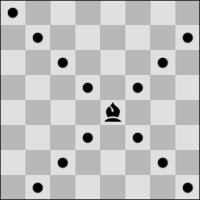 |
| 3.3 |
The rook may move to any square along the file or the rank on which it stands.>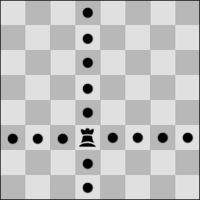 |
| 3.4 |
The queen may move to any square along the file, the rank or a diagonal on which it stands. |
| 3.5 |
When making these moves the bishop, rook or queen may not move over any intervening pieces. |
| 3.6 |
The knight may move to one of the squares nearest to that on which it stands but not on the same rank, file or diagonal.
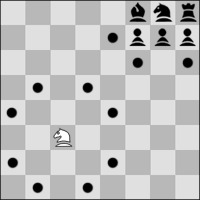
|
| 3.7 |
-
The pawn may move forward to the unoccupied square immediately in front of it on the same file, or
-
on its first move the pawn may move as in (a); alternatively it may advance two squares along the same file provided both squares are unoccupied, or
-
the pawn may move to a square occupied by an opponent`s piece, which is diagonally in front of it on an adjacent file, capturing that piece.

-
Ad. A pawn attacking a square crossed by an opponent`s pawn which has advanced two squares in one move from its original square may capture this opponent`s pawn as though the latter had been moved only one square. This capture is only legal on the move following this advance and is called an `en passant` capture.
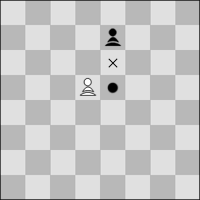
-
When a pawn reaches the rank furthest from its starting position it must be exchanged as part of the same move for a new queen, rook, bishop or knight of the same colour. The player`s choice is not restricted to pieces that have been captured previously. This exchange of a pawn for another piece is called `promotion` and the effect of the new piece is immediate.
|
| 3.8 |
a. There are two different ways of moving the king, by:
-
moving to any adjoining square not attacked by one or more of the opponent`s pieces.
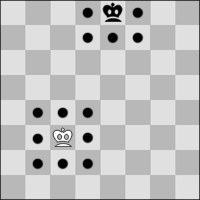 or or
-
`castling`. This is a move of the king and either rook of the same colour on the same rank, counting as a single move of the king and executed as follows: the king is transferred from its original square two squares towards the rook, then that rook is transferred to the square the king has just crossed.
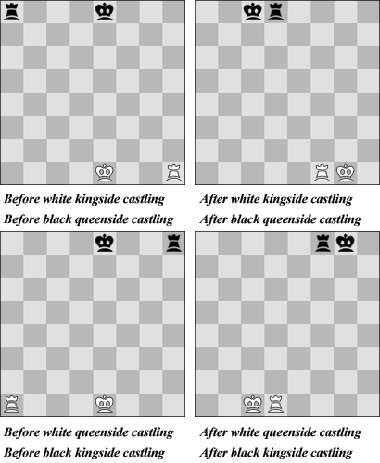
(1) The right for castling has been lost:
-
if the king has already moved, or
-
with a rook that has already moved
(2) Castling is prevented temporarily
-
if the square on which the king stands, or the square which it must cross, or the square which it is to occupy, is attacked by one or more of the opponent`s pieces.
-
if there is any piece between the king and the rook with which castling is to be effected.
|
| 3.9 |
The king is said to be `in check` if it is attacked by one or more of the opponent`s pieces, even if such pieces are constrained from moving to that square because they would then leave or place their own king in check. No piece can be moved that will either expose the king of the same colour to check or leave that king in check. |
| Article 4: The act of moving the pieces |
| 4.1 |
Each move must be made with one hand only. |
| 4.2 |
Provided that he first expresses his intention (e.g. by saying "j`adoube" or "I adjust"), the player having the move may adjust one or more pieces on their squares. |
| 4.3 |
Except as provided in Article 4.2, if the player having the move deliberately touches on the chessboard
-
one or more of his own pieces, he must move the first piece touched that can be moved, or
-
one or more of his opponent`s pieces, he must capture the first piece touched, which can be captured, or
-
one piece of each colour, he must capture the opponent`s piece with his piece or, if this is illegal, move or capture the first piece touched which can be moved or captured. If it is unclear, whether the player`s own piece or his opponent`s was touched first, the player`s own piece shall be considered to have been touched before his opponent`s.
|
| 4.4 |
-
If a player deliberately touches his king and rook he must castle on that side if it is legal to do so.
-
If a player deliberately touches a rook and then his king he is not allowed to castle on that side on that move and the situation shall be governed by Article 4.3(a).
-
If a player, intending to castle, touches the king or king and rook at the same time, but castling on that side is illegal, the player must make another legal move with his king which may include castling on the other side. If the king has no legal move, the player is free to make any legal move.
-
If a player promotes a pawn, the choice of the piece is finalised, when the piece has touched the square of promotion.
|
| 4.5 |
If none of the pieces touched can be moved or captured, the player may make any legal move. |
| 4.6 |
When, as a legal move or part of a legal move, a piece has been released on a square, it cannot then be moved to another square. The move is considered to have been made when all the relevant requirements of Article 3 have been fulfilled.
-
in the case of a capture, when the captured piece has been removed from the chessboard and the player, having placed his own piece on its new square, has released this capturing piece from his hand;
-
in the case of castling, when the player`s hand has released the rook on the square previously crossed by the king. When the player has released the king from his hand, the move is not yet made, but the player no longer has the right to make any move other than castling on that side, if this is legal;
-
in the case of the promotion of a pawn, when the pawn has been removed from the chessboard and the player`s hand has released the new piece after placing it on the promotion square. If the player has released from his hand the pawn that has reached the promotion square, the move is not yet made, but the player no longer has the right to play the pawn to another square.
|
| 4.7 |
A player forfeits his right to a claim against his opponent`s violation of Article 4.3 or 4.4, once he deliberately touches a piece. |
| Article 5: The completion of the game |
| 5.1 |
-
The game is won by the player who has checkmated his opponent`s king. This immediately ends the game, provided that the move producing the checkmate position was a legal move.
-
The game is won by the player whose opponent declares he resigns. This immediately ends the game.
|
| 5.2 |
-
The game is drawn when the player to move has no legal move and his king is not in check. The game is said to end in `stalemate`. This immediately ends the game, provided that the move producing the stalemate position was legal.
-
The game is drawn when a position has arisen in which neither player can checkmate the opponent`s king with any series of legal moves. The game is said to end in a `dead position`. This immediately ends the game, provided that the move producing the position was legal.
-
The game is drawn upon agreement between the two players during the game. This immediately ends the game. (See Article 9.1)
-
The game may be drawn if any identical position is about to appear or has appeared on the chessboard at least three times. (See Article 9.2)
-
The game may be drawn if each player has made at least the last 50 consecutive moves without the movement of any pawn and without any capture. (See Article 9.3)
|
| COMPETITION RULES |
| Article 6: The chess clock |
| 6.1 |
`Chess clock` means a clock with two time displays, connected to each other in such a way that only one of them can run at one time. `Clock` in the Laws of Chess means one of the two time displays. `Flag fall` means the expiration of the allotted time for a player. |
| 6.2 |
-
When using a chess clock, each player must make a minimum number of moves or all moves in an allotted period of time and/or may be allocated an additional amount of time with each move. All these must be specified in advance.
-
The time saved by a player during one period is added to his time available for the next period, except in the `time delay` mode. In the time delay mode both players receive an allotted `main thinking time`. Each player also receives a `fixed extra time` with every move. The countdown of the main time only commences after the fixed time has expired. Provided the player stops his clock before the expiration of the fixed time, the main thinking time does not change, irrespective of the proportion of the fixed time used.
|
| 6.3 |
Each time display has a `flag`. Immediately after a flag falls, the requirements of Article 6.2(a) must be checked. |
| 6.4 |
Before the start of the game the arbiter decides where the chess clock is placed. |
| 6.5 |
At the time determined for the start of the game the clock of the player who has the white pieces is started. |
| 6.6 |
If neither player is present initially, the player who has the white pieces shall lose all the time that elapses until he arrives; unless the rules of the competition specify or the arbiter decides otherwise. |
| 6.7 |
Any player who arrives at the chessboard more than one hour after the scheduled start of the session shall lose the game unless the rules of the competition specify or the arbiter decides otherwise. |
| 6.8 |
-
During the game each player, having made his move on the chessboard, shall stop his own clock and start his opponent`s clock. A player must always be allowed to stop his clock. His move is not considered to have been completed until he has done so, unless the move that was made ends the game. (See Articles 5.1, and 5.2) The time between making the move on the chessboard and stopping his own clock and starting his opponent`s clock is regarded as part of the time allotted to the player.
-
A player must stop his clock with the same hand as that with which he made his move. It is forbidden for a player to keep his finger on the button or to `hover` over it.
-
The players must handle the chess clock properly. It is forbidden to punch it forcibly, to pick it up or to knock it over. Improper clock handling shall be penalised in accordance with Article 13.4.
-
If a player is unable to use the clock, an assistant, who is acceptable to the arbiter, may be provided by the player to perform this operation. His clock shall be adjusted by the arbiter in an equitable way.
|
| 6.9 |
A flag is considered to have fallen when the arbiter observes the fact or when either player has made a valid claim to that effect. |
| 6.10 |
Except where Articles 5.1 or one of the Articles 5.2 (a), (b) and (c) apply, if a player does not complete the prescribed number of moves in the allotted time, the game is lost by the player. However, the game is drawn, if the position is such that the opponent cannot checkmate the player`s king by any possible series of legal moves, even with the most unskilled counterplay. |
| 6.11 |
Every indication given by the clocks is considered to be conclusive in the absence of any evident defect. A chess clock with an evident defect shall be replaced. The arbiter shall replace the clock and use his best judgement when determining the times to be shown on the replacement chess clock. |
| 6.12 |
If both flags have fallen and it is impossible to establish which flag fell first, then
-
the game shall continue if it happens in any period of the game except the last period.
-
the game is drawn in case it happens in the period of a game, in which all remaining moves must be completed.
|
| 6.13 |
-
If the game needs to be interrupted, the arbiter shall stop the clocks.
-
A player may stop the clocks only in order to seek the arbiter`s assistance, for instance when promotion has taken place and the piece required is not available.
-
The arbiter shall decide when the game is to be restarted in either case.
-
If a player stops the clocks in order to seek the arbiter`s assistance, the arbiter shall determine if the player had any valid reason for doing so. If it is obvious that the player has no valid reason for stopping the clocks, the player shall be penalised according to article 13.4.
|
| 6.14 |
If an irregularity occurs and/or the pieces have to be restored to a previous position, the arbiter shall use his best judgement to determine the times to be shown on the clocks. He shall also, if necessary, adjust the clock`s move counter. |
| 6.15 |
Screens, monitors, or demonstration boards showing the current position on the chessboard, the moves and the number of moves made, and clocks which also show the number of moves, are allowed in the playing hall. However, the player may not make a claim relying solely on information shown in this manner. |
| Article 7: Irregularities |
| 7.1 |
-
If during a game it is found that the initial position of the pieces was incorrect, the game shall be cancelled and a new game played.
-
If during a game it is found that the only error is that the chessboard has been placed contrary to Article 2.1, the game continues but the position reached must be transferred to a correctly placed chessboard.
|
| 7.2 |
If a game has begun with colours reversed, then it shall continue, unless the arbiter rules otherwise. |
| 7.3 |
If a player displaces one or more pieces, he shall re-establish the correct position on his own time. If necessary, either the player or his opponent shall stop the clocks and ask for the arbiter`s assistance. The arbiter may penalise the player who displaced the pieces. |
| 7.4 |
-
If during a game it is found that an illegal move, including failing to meet the requirements of the promotion of a pawn or capturing the opponent’s king, has been completed, the position immediately before the irregularity shall be reinstated. If the position immediately before the irregularity cannot be determined, the game shall continue from the last identifiable position prior to the irregularity. The clocks shall be adjusted according to Article 6.14. Article 4.3 applies to the move replacing the illegal move. The game shall then continue from this reinstated position.
-
After the action taken under Article 7.4(a), for the first two illegal moves by a player the arbiter shall give two minutes extra time to his opponent in each instance; for a third illegal move by the same player, the arbiter shall declare the game lost by this player.
|
| 7.5 |
If during a game it is found that pieces have been displaced from their squares, the position before the irregularity shall be reinstated. If the position immediately before the irregularity cannot be determined, the game shall continue from the last identifiable position prior to the irregularity. The clocks shall be adjusted according to Article 6.14. The game shall then continue from this reinstated position. |
| Article 8: The recording of the moves |
| 8.1 |
In the course of play each player is required to record his own moves and those of his opponent in the correct manner, move after move, as clearly and legibly as possible, in the algebraic notation (Appendix E), on the ‘scoresheet’ prescribed for the competition. It is forbidden to write the moves in advance, unless the player is claiming a draw according to Article 9.2 or 9.3. A player may reply to his opponent`s move before recording it, if he so wishes. He must record his previous move before making another. Both players must record the offer of a draw on the scoresheet. (Appendix E.13) If a player is unable to keep score, an assistant, who is acceptable to the arbiter, may be provided by the player to write the moves. His clock shall be adjusted by the arbiter in an equitable way. |
| 8.2 |
The scoresheet shall be visible to the arbiter throughout the game. |
| 8.3 |
The scoresheets are the property of the organisers of the event. |
| 8.4 |
If a player has less than five minutes left on his clock at some stage in a period and does not have additional time of 30 seconds or more added with each move, then he is not obliged to meet the requirements of Article 8.1. Immediately after one flag has fallen the player must update his scoresheet completely before moving a piece on the chessboard |
| 8.5 |
-
If neither player is required to keep score under Article 8.4, the arbiter or an assistant should try to be present and keep score. In this case, immediately after one flag has fallen, the arbiter shall stop the clocks. Then both players shall update their scoresheets, using the arbiter`s or the opponent`s scoresheet.
-
If only one player is not required to keep score under Article 8.4 he must, as soon as either flag has fallen, update his scoresheet completely before moving a piece on the chessboard. Provided it is the player`s move, he may use his opponent`s scoresheet, but must return it before making a move
-
If no complete scoresheet is available, the players must reconstruct the game on a second chessboard under the control of the arbiter or an assistant. He shall first record the actual game position, clock times and the number of moves made, if this information is available, before reconstruction takes place.
|
| 8.6 |
If the scoresheets cannot be brought up-to-date showing that a player has overstepped the allotted time, the next move made shall be considered as the first of the following time period, unless there is evidence that more moves have been made. |
| 8.7 |
At the conclusion of the game both players shall sign both scoresheets, indicating the result of the game. Even if incorrect, this result shall stand, unless the arbiter decides otherwise. |
| Article 9: The drawn game |
| 9.1 |
-
A player wishing to offer a draw shall do so after having made a move on the chessboard and before stopping his clock and starting the opponent`s clock. An offer at any other time during play is still valid, but Article 12.6 must be considered. No conditions can be attached to the offer. In both cases the offer cannot be withdrawn and remains valid until the opponent accepts it, rejects it orally, rejects it by touching a piece with the intention of moving or capturing it, or the game is concluded in some other way.
-
The offer of a draw shall be noted by each player on his scoresheet with a symbol (See Appendix E13).
-
A claim of a draw under 9.2, 9.3 or 10.2 shall be considered to be an offer of a draw.
|
| 9.2 |
The game is drawn, upon a correct claim by the player having the move, when the same position, for at least the third time (not necessarily by a repetition of moves)
-
is about to appear, if he first writes his move on his scoresheet and declares to the arbiter his intention to make this move, or
-
has just appeared, and the player claiming the draw has the move.
Positions as in (a) and (b) are considered the same, if the same player has the move, pieces of the same kind and colour occupy the same squares, and the possible moves of all the pieces of both players are the same. Positions are not the same if a pawn that could have been captured en passant can no longer in this manner be captured or if the right to castle has been changed temporarily or permanently. |
| 9.3 |
The game is drawn, upon a correct claim by the player having the move, if
-
he writes his move on his scoresheet, and declares to the arbiter his intention to make this move which shall result in the last 50 moves having been made by each player without the movement of any pawn and without any capture, or
-
the last 50 consecutive moves have been made by each player without the movement of any pawn and without any capture.
|
| 9.4 |
If the player makes a move without having claimed the draw he loses the right to claim, as in Article 9.2 or 9.3, on that move. |
| 9.5 |
If a player claims a draw as in Article 9.2 or 9.3, he shall immediately stop both clocks. He is not allowed to withdraw his claim.
-
If the claim is found to be correct the game is immediately drawn.
-
If the claim is found to be incorrect, the arbiter shall add three minutes to the opponent`s remaining time. Additionally, if the claimant has more than two minutes on his clock the arbiter shall deduct half of the claimant`s remaining time up to a maximum of three minutes. If the claimant has more than one minute, but less than two minutes, his remaining time shall be one minute. If the claimant has less than one minute, the arbiter shall make no adjustment to the claimant`s clock. Then the game shall continue and the intended move must be made.
|
| 9.6 |
The game is drawn when a position is reached from which a checkmate cannot occur by any possible series of legal moves, even with the most unskilled play. This immediately ends the game, provided that the move producing this position was legal. |
| Article 10: Quickplay Finish |
| 10.1 |
A `quickplay finish` is the phase of a game, when all the (remaining) moves must be made in a limited time. |
| 10.2 |
If the player, having the move, has less than two minutes left on his clock, he may claim a draw before his flag falls. He shall stop the clocks and summon the arbiter.
-
If the arbiter agrees the opponent is making no effort to win the game by normal means, or that it is not possible to win by normal means, then he shall declare the game drawn. Otherwise he shall postpone his decision or reject the claim.
-
b. If the arbiter postpones his decision, the opponent may be awarded two extra minutes and the game shall continue in the presence of an arbiter, if possible. The arbiter shall declare the final result later in the game or after a flag has fallen. He shall declare the game drawn if he agrees that the final position cannot be won by normal means, or that the opponent was not making sufficient attempts to win by normal means.
-
If the arbiter has rejected the claim, the opponent shall be awarded two extra minutes time.
-
The decision of the arbiter shall be final relating to 10.2 a, b, c.
|
| Article 11: Scoring |
| 11.1 |
Unless announced otherwise in advance, a player who wins his game, or wins by forfeit, scores one point (1), a player who loses his game, or forfeits scores no points (0) and a player who draws his game scores a half point (1/2). |
| Article 12: The conduct of the players |
| 12.1 |
The players shall take no action that will bring the game of chess into disrepute. |
| 12.2 |
-
During play the players are forbidden to make use of any notes, sources of information, advice, or analyse on another chessboard.
-
It is strictly forbidden to bring mobile phones or other electronic means of communication, not authorised by the arbiter, into the playing venue. If a player`s mobile phone rings in the playing venue during play, that player shall lose the game. The score of the opponent shall be determined by the arbiter.
|
| 12.3 |
The scoresheet shall be used only for recording the moves, the times of the clocks, the offers of a draw, matters relating to a claim and other relevant data. |
| 12.4 |
Players who have finished their games shall be considered to be spectators. |
| 12.5 |
Players are not allowed to leave the `playing venue` without permission from the arbiter. The playing venue is defined as the playing area, rest rooms, refreshment area, area set aside for smoking and other places as designated by the arbiter. The player having the move is not allowed to leave the playing area without permission of the arbiter. |
| 12.6 |
It is forbidden to distract or annoy the opponent in any manner whatsoever. This includes unreasonable claims or unreasonable offers of a draw. |
| 12.7 |
Infraction of any part of the Articles 12.1 to 12.6 shall lead to penalties in accordance with Article 13.4. |
| 12.8 |
Persistent refusal by a player to comply with the Laws of Chess shall be penalised by loss of the game. The arbiter shall decide the score of the opponent. |
| 12.9 |
If both players are found guilty according to Article 12.8, the game shall be declared lost by both players. |
| Article 13: The role of the arbiter (see Preface) |
| 13.1 |
The arbiter shall see that the Laws of Chess are strictly observed. |
| 13.2 |
The arbiter shall act in the best interest of the competition. He should ensure that a good playing environment is maintained and that the players are not disturbed. He shall supervise the progress of the competition. |
| 13.3 |
The arbiter shall observe the games, especially when the players are short of time, enforce decisions he has made and impose penalties on players where appropriate. |
| 13.4 |
The arbiter can apply one or more of the following penalties:
-
warning,
-
increasing the remaining time of the opponent,
-
reducing the remaining time of the offending player,
-
declaring the game to be lost,
-
reducing the points scored in a game by the offending party,
-
increasing the points scored in a game by the opponent to the maximum available for that game,
-
expulsion from the event.
|
| 13.5 |
The arbiter may award either or both players additional time in the event of external disturbance of the game. |
| 13.6 |
The arbiter must not intervene in a game except in cases described by the Laws of Chess. He shall not indicate the number of moves made, except in applying Article 8.5 when at least one flag has fallen. The arbiter shall refrain from informing a player that his opponent has completed a move or that the player has not pressed his clock. |
| 13.7 |
-
Spectators and players in other games are not to speak about or otherwise interfere in a game. If necessary, the arbiter may expel offenders from the playing venue.
-
It is forbidden for anybody to use a mobile phone in the playing venue and any area designated by the arbiter
|
| Article 14: FIDE |
| 14.1 |
Member federations may ask FIDE to give an official decision about problems relating to the Laws of Chess.
From http://www.fide.com |

